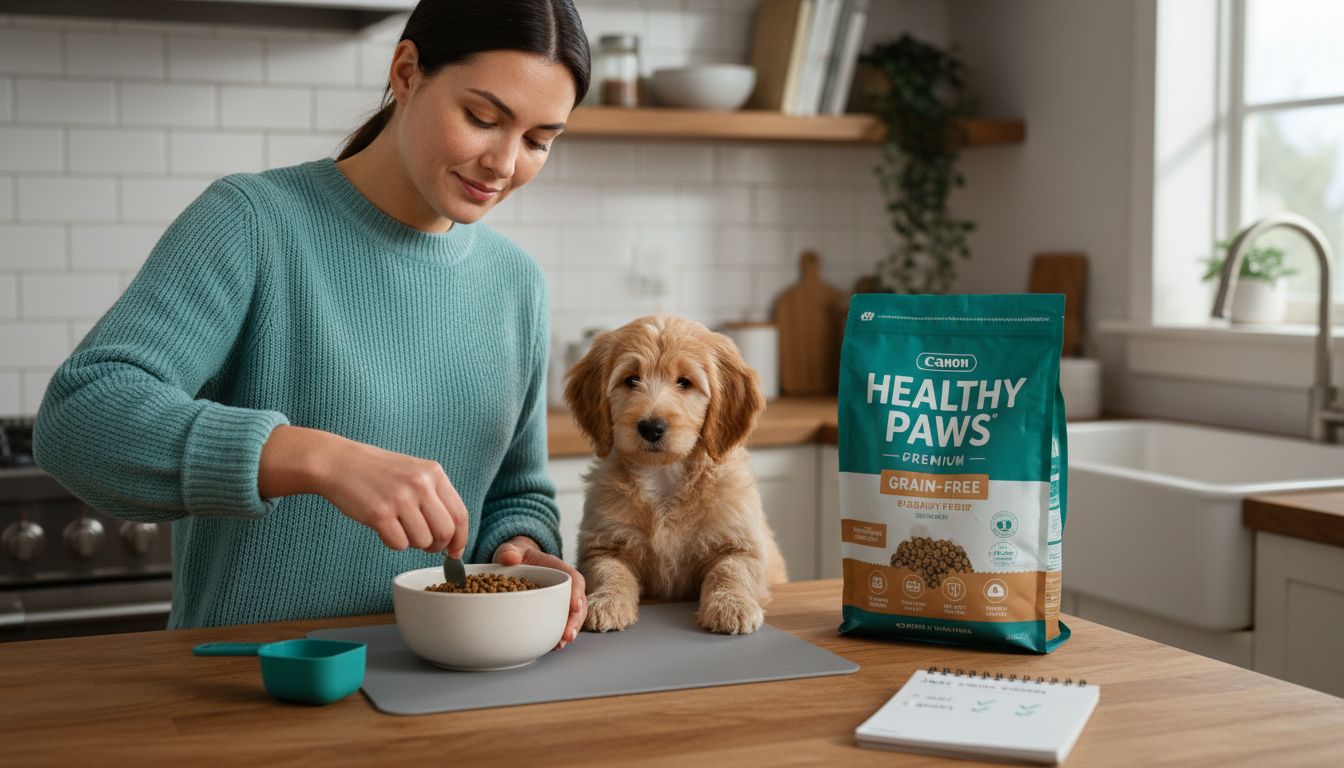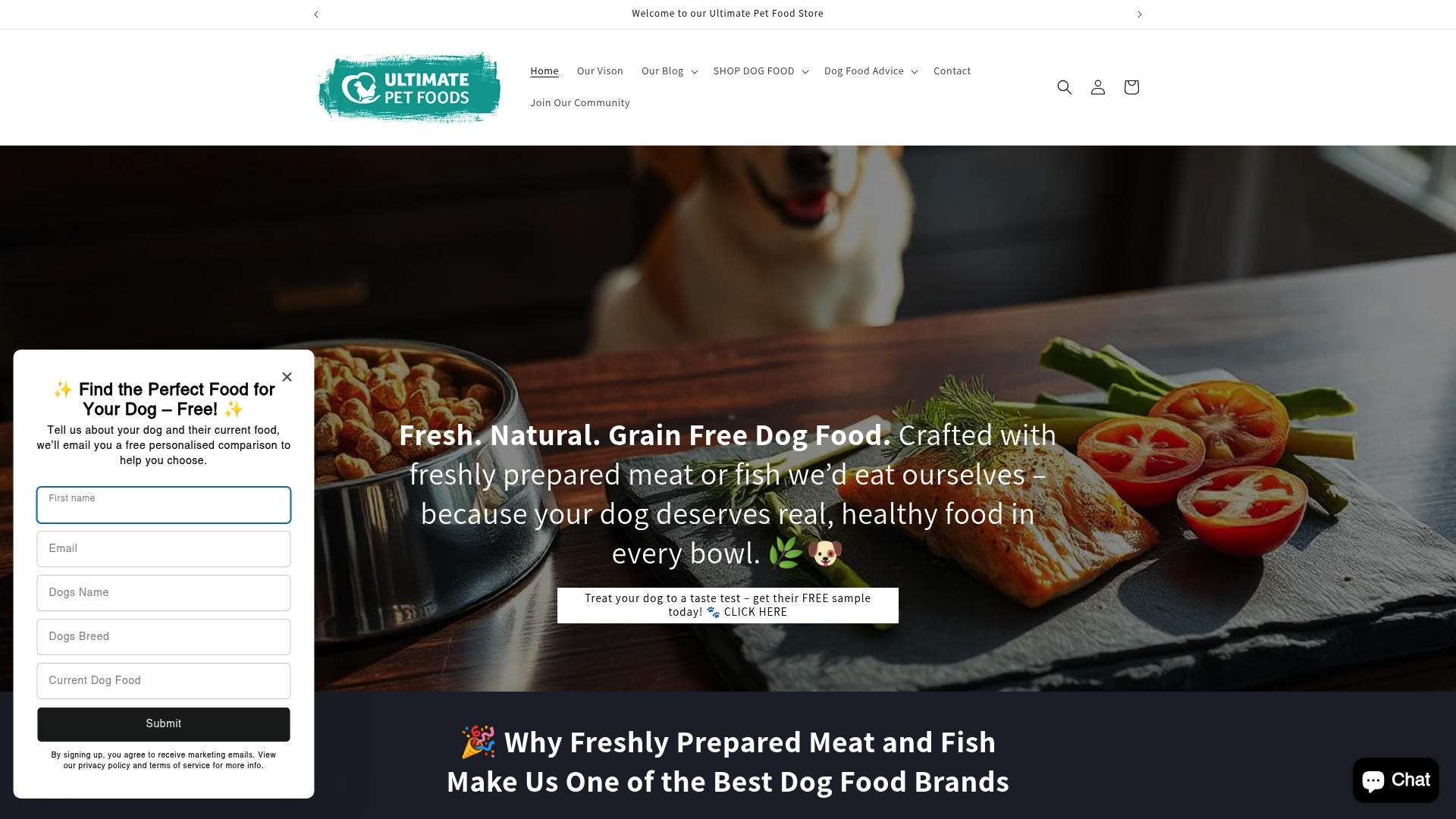Portion Sizes for Puppies: Your Step-By-Step Feeding Guide

Share
Did you know that rapid puppy growth can put dangerous stress on developing joints and even lead to long term health problems? Getting your puppy’s nutrition right from the start is one of the most important choices you’ll make as a dog owner. With so many feeding options and expert recommendations, finding the right portion and formula for your puppy can feel overwhelming. Clear steps and evidence-based tips make it much easier to give your puppy exactly what they need for healthy development.
Table of Contents
- Step 1: Assess Your Puppy’s Breed And Growth Stage
- Step 2: Choose A Suitable Natural, Grain-Free Formula
- Step 3: Calculate The Recommended Portion Size
- Step 4: Measure And Prepare Daily Puppy Meals
- Step 5: Monitor Your Puppy’s Weight And Condition
- Step 6: Adjust Portion Sizes For Ongoing Healthy Development
Quick Summary
| Key Point | Explanation |
|---|---|
| 1. Assess breed and growth stage | Knowing your puppy’s breed and growth stage is essential to determine the right nutrition and portion sizes for their development. |
| 2. Choose a grain-free formula | Opt for a high-quality, grain-free diet to support digestion and replicate your puppy’s natural dietary needs for healthy growth. |
| 3. Calculate portion sizes accurately | Feed puppies 4-6% of their current body weight, adjusting based on age, breed size, and growth rate to ensure proper nutrition. |
| 4. Monitor weight and body condition | Regularly weigh your puppy and assess their condition to prevent overfeeding or undernourishment and ensure they are growing healthily. |
| 5. Adjust portions as they grow | Continuously adapt portion sizes according to your puppy’s growth and nutritional needs, working with a veterinarian for personalized guidance. |
Step 1: Assess your puppy’s breed and growth stage
Knowing your puppy’s specific breed and growth stage is crucial for determining accurate portion sizes. This step helps you provide precisely tailored nutrition that supports healthy development.
Start by gathering key information about your puppy. According to research from the Royal Veterinary College, puppies require a balanced nutritional approach that varies significantly based on their specific breed and growth rate. Large breed puppies, for instance, have different nutritional needs compared to small breed puppies.
To assess your puppy’s requirements, consider these key factors:
- Breed size (toy, small, medium, large, giant)
- Current age in weeks or months
- Anticipated adult weight
- Specific breed growth characteristics
Look closely at your puppy’s breed standards. Some breeds grow rapidly and require carefully managed nutrition to prevent joint stress. As research from Prospect House Veterinary Clinic indicates, growing too quickly can put significant strain on joints and potentially cause long term health problems.
For precise nutritional guidance, check our guide on understanding life stage dog food which provides detailed insights into breed specific nutrition.
Pro Tip: Consult with your veterinarian for a professional assessment of your specific puppy’s growth trajectory and nutritional needs.
In the next step, we will translate these breed insights into specific portion recommendations that support your puppy’s healthy development.
Here’s a summary of key feeding considerations by puppy growth stage:
| Growth Stage | Portion Size Guidance | Meal Frequency | Monitoring Focus |
|---|---|---|---|
| Early Puppyhood (8-12 weeks) |
4-6% body weight (daily) | 4 meals/day | Weekly weighing Body condition score |
| Rapid Growth (3-6 months) |
4-6% body weight (adjust as needed) | 3 meals/day | Monitor waistline Growth consistency |
| Transition to Junior (6-12 months) |
3-4% body weight (as growth slows) | 2-3 meals/day | Adjust for slowed growth Monthly photo check |
| Near Adult Size (12+ months) |
Switch to adult portions | 2 meals/day | Maintain body condition |
Step 2: Choose a suitable natural, grain-free formula
Selecting the right puppy formula is critical for supporting healthy growth and development. In this step, you will learn how to identify a nutritionally balanced grain-free diet that meets your puppy’s specific needs.
Look for formulas that closely mimic natural nutritional patterns. According to research on Biologically Appropriate Raw Food (BARF), your puppy’s diet should replicate what they might have eaten in the wild: high quality proteins, essential vegetables, and critical minerals. Our freshly prepared kibble contains gentle cooked meats at 82 degrees to lock in nutrients and support optimal digestion.
Key factors to consider when choosing a formula include:
- Protein source quality and digestibility
- Absence of artificial preservatives
- Inclusion of natural prebiotics
- Balanced mineral content
- Specific nutritional requirements for puppy growth
Understanding the benefits of a grain-free diet can help you make an informed choice about your puppy’s nutrition. Grain-free formulas reduce potential digestive irritation and support more natural eating patterns.
Pro Tip: Always transition to new foods gradually to prevent digestive upset and monitor your puppy’s response.
In our next step, we will explore precise portion calculations that match your puppy’s unique growth requirements.
Step 3: Calculate the recommended portion size
Calculating the right portion size is crucial for your puppy’s healthy growth and development. This step will help you determine the precise amount of food your puppy needs based on their unique characteristics.
According to research from Nutriment, puppies have specific nutritional requirements that differ from adult dogs. They typically need to be fed 4 to 6 percent of their growing body weight. However, this is just a general guideline and individual needs can vary significantly.
To calculate the right portion size, follow these key steps:
- Weigh your puppy accurately using a reliable scale
- Consider your puppy’s breed size and expected adult weight
- Factor in your puppy’s current age and growth rate
- Monitor your puppy’s body condition and adjust portions accordingly
Our freshly prepared kibble is designed with precise nutritional balance, containing gentle cooked meats at 82 degrees to lock in essential nutrients. Master dog food portion control for optimal nutrition can provide additional insights into maintaining the right balance.
Pro Tip: Divide daily recommended portions into multiple smaller meals to support steady energy and optimal digestion.
In the next step, we will explore how to establish a consistent feeding schedule that supports your puppy’s growth and development.
Step 4: Measure and prepare daily puppy meals
Measuring and preparing your puppy’s daily meals requires precision and consistency. This step will guide you through creating nutritionally balanced meals that support your puppy’s growth and development.
Precision is key when portioning meals. According to Nutriment research, puppies require 4 to 6 percent of their growing body weight in daily nutrition. Our freshly prepared kibble makes this process straightforward with its carefully balanced formulation.
Essential steps for meal preparation include:
- Use a digital kitchen scale for accurate measurement
- Divide daily recommended portion into multiple smaller meals
- Measure kibble using the specific scoop provided with your food package
- Maintain consistent meal times to support digestive health

Our kibble contains freshly prepared meats gently cooked at 82 degrees to preserve nutritional integrity. Check out our complete guide to dry puppy food for additional insights into optimal feeding practices.
Pro Tip: Always have fresh water available alongside meals and store kibble in a cool dry place to maintain nutritional quality.
In our next step, we will explore how to monitor your puppy’s response to their new feeding routine and make necessary adjustments.
Step 5: Monitor your puppy’s weight and condition
Monitoring your puppy’s weight and physical condition is critical for ensuring healthy growth and preventing potential developmental issues. This step will help you track your puppy’s nutritional progress and make informed adjustments.
According to research from the Royal Veterinary College, the rate of growth is a significant factor that can be carefully controlled by attentive owners. Prospect House Veterinary Clinic emphasises that growing too quickly can place unnecessary strain on developing joints and potentially lead to long term health complications.
Key strategies for effective monitoring include:
- Weigh your puppy weekly using a consistent scale
- Assess body condition through visual and tactile examination
- Look for a visible waistline when viewed from above
- Feel for ribs which should be easily felt but not visibly protruding
Our freshly prepared kibble supports steady nutritional development with gentle cooking at 82 degrees to preserve essential nutrients. Learn how much to feed your dog naturally for additional comprehensive guidance.
Pro Tip: Photograph your puppy monthly to track physical changes and discuss growth patterns with your veterinarian during regular check ups.
In our final step, we will discuss how to adjust feeding as your puppy transitions through different growth stages.
Step 6: Adjust portion sizes for ongoing healthy development
As your puppy grows, their nutritional needs will continuously change. This step focuses on understanding how to adapt portion sizes to support optimal health and prevent overfeeding or undernourishment.
According to Nutriment research, puppies require 4 to 6 percent of their growing body weight in nutrition. However, this percentage will gradually decrease as your puppy transitions toward adult proportions. Our freshly prepared kibble is designed to support these changing nutritional requirements with precisely balanced ingredients.
Key strategies for adjusting portion sizes include:
- Reassess your puppy’s weight every two to four weeks
- Compare current weight against breed standard growth charts
- Reduce portion sizes incrementally as growth rate slows
- Maintain consistent meal frequency while modifying quantity
Expert tips for transitioning dog foods successfully can provide additional guidance on managing nutritional changes throughout your puppy’s development.
Pro Tip: Work with your veterinarian to create a personalised nutrition plan that accounts for your specific puppy’s breed, metabolism, and activity level.
By carefully monitoring and adjusting portion sizes, you will set the foundation for your puppy’s lifelong health and wellbeing.
Ensure Perfect Portion Sizes with Naturally Tailored Nutrition
Feeding your puppy the right portion size can feel overwhelming, especially when you want to provide exactly what they need for healthy growth without overfeeding or undernourishing. This guide has highlighted how important it is to consider your puppy’s breed, growth stage, and unique nutritional needs. At Ultimate Pet Foods, we understand these challenges and offer premium, grain-free dog food formulas designed specifically to support puppies at every stage of their development.

Explore our carefully prepared ranges including Premium Dry Dog Food for a Happy and Healthy Pup to find the perfect match for your little companion. For a taste test before committing, try All Our Dog Food Samples – Ultimate Pet Foods. Visit Ultimate Pet Foods today to discover nutritious, natural options made to promote steady growth and vitality. Start giving your puppy the nutrition they deserve now and set them up for a lifetime of health.
Frequently Asked Questions
How do I determine my puppy’s portion size?
To determine your puppy’s portion size, weigh your puppy and multiply their current body weight by 4-6% for daily food intake. For example, if your puppy weighs 10 pounds, they would require approximately 0.4 to 0.6 pounds of food daily. Adjust this amount as they grow to ensure proper nutritional intake.
What should I consider when feeding large breed puppies?
Large breed puppies have unique nutritional needs to prevent rapid growth that can stress their joints. Focus on a balanced diet that is specifically formulated for large breeds, and monitor their growth closely by weighing them every 2-4 weeks.
How often should I feed my puppy during different growth stages?
In the early puppyhood stage (8-12 weeks), feed 4 meals a day, then transition to 3 meals per day from 3 to 6 months, and finally reduce to 2 meals daily after reaching 12 months. Stick to this schedule to support healthy digestion and consistent energy levels throughout their growth phases.
How can I adjust my puppy’s food portions as they grow?
Reassess your puppy’s weight every 2-4 weeks and compare their current weight against breed-standard growth charts. As growth slows, gradually reduce their food portions to approximately 3-4% of body weight to maintain a healthy weight.





